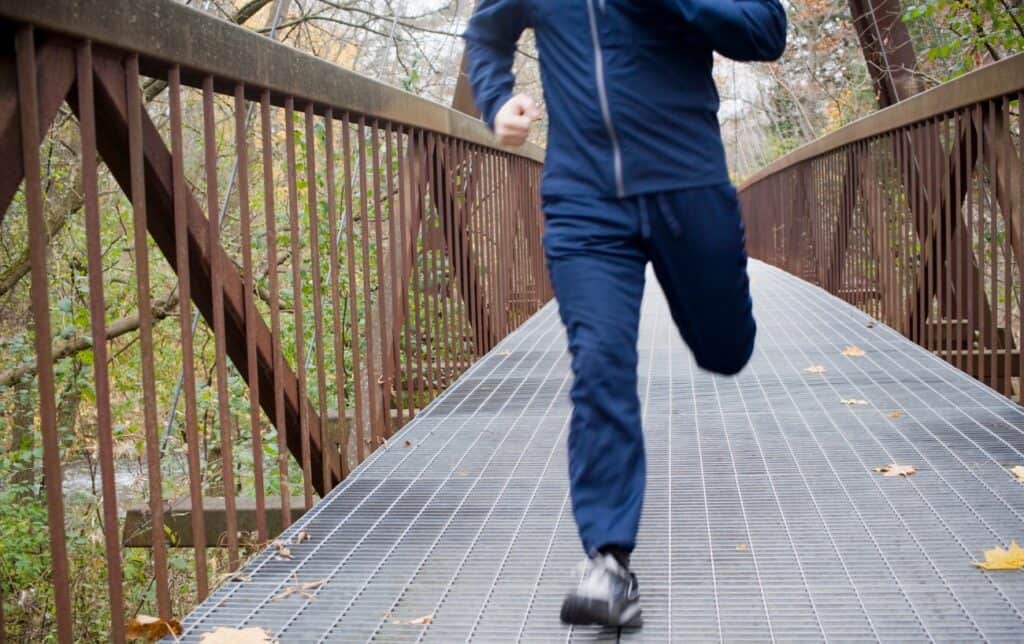Have your runs become routine and maybe even a little boring? Do you find yourself settling into the same pace for every run, zoning out as you log the miles, and not really feeling challenged or excited?
If so, it might be time to shake things up—with a fartlek run.
Fartlek is a Swedish word that means “speed play,” and that’s exactly what this workout brings to your training: a playful, unstructured way to add speed and variety to your runs.
I love prescribing fartleks to runners at all levels because they break the monotony, encourage mindfulness and responsiveness during runs, and offer a powerful blend of aerobic and anaerobic training. They’re incredibly effective for improving speed, endurance, and mental focus without the pressure of rigid structure.
You can keep it casual or make it challenging, but either way, fartleks add variety, build strength, and make running feel fun again. And let’s face it: if you’re enjoying your training, you’re far more likely to stick with it, and get faster in the process.
Ready to bring the joy (and speed) back to your miles? Let’s get into how fartleks work and how you can start using them in your weekly training.

What Is A Fartlek Run?
Fartlek runs are a type of interval training designed to blend speed and endurance work in a fun, flexible format.
The concept originated in the 1930s, developed by Gustaf “Gösta” Holmér while coaching the Swedish cross country team. Holmér introduced bursts of faster running within longer efforts, aiming to improve both aerobic endurance and running speed.
The results spoke for themselves, and his method quickly gained popularity across the running world.
While fartlek runs can take many forms, they’re typically unstructured. Runners alternate between periods of faster and slower running, often using natural landmarks—like trees, streetlights, or hills—to dictate the pace shifts.
Fartleks are easy to adapt to any fitness level and are a great way to challenge your body without the pressure of rigid splits or track intervals.
Whether you’re building endurance, sharpening speed, or just trying to make your runs more fun, fartleks offer a flexible and effective way to reinvigorate your training.
How Do Fartleks Differ From Regular Interval workouts?
Both involve periods of faster running, but traditional interval training is far more structured.
A typical interval session might include, for example, 6 x 800 meters at a specific pace, with timed rest intervals (like 90 seconds of walking or standing recovery) between reps.
These workouts are often done on a track to maintain precise pacing and distance, making them ideal for sharpening speed or preparing for specific race goals.
Fartleks, by contrast, are less rigid and often more playful. You might speed up for 1 minute, then recover for 2, or sprint to the next tree and jog to the next stop sign—there’s no stopwatch or set distance required.
And unlike interval training, fartleks are best done on roads, trails, or open paths—not a track—so they can mimic real-world running conditions and terrain.
In short, fartlek runs give you the benefits of speed work without the pressure of precision, making them a fantastic tool for improving both fitness and mental engagement, especially when your training needs a shake-up.

Why Fartlek Runs Work: 4 Key Benefits
#1: Build Both Speed and Endurance
As fartlek runs are typically longer runs with fast portions incorporated throughout, they force runners to adapt to different speeds over several miles and thus help improve both speed and endurance.
#2: Prepare You for Real-World Racing
Fartlek runs also help prepare runners for racing, as the randomness of the fast portions and the continuous nature of the overall run mimics race situations, where runners may need to pick up the pace intermittently in order to pass someone or meet a time goal.
#3: Make Speed Work More Enjoyable
While these runs are not necessarily easier than any other type of run, they may be less stressful and more enjoyable simply because the runner has more control of the intervals and pacing.
And, as most runners know, if we perceive a run as less stressful and more enjoyable, we are more likely to do them, which is always a positive.
#4: Keep Your Mind Engaged
Fartlek runs also keep runners more engaged and present.
Because these runs require frequent adjustments of pace based on elements and landmarks along the running route, they force the runner to stay focused and aware.
While it is sometimes pleasant to “zone out” during a run, being mindful of pace and surroundings can be helpful when trying to progress as a runner.
Related: Progression Runs Guide: Ramp Up Runs + 4 Progression Workouts To Try Out
How Often Should I Do a Fartlek Run?
Due to the flexible nature of a fartlek run, these workouts can be incorporated into a runnning schedule on a regular basis.
Depending on the length of the run and number of , distance, and pace of the faster portions, these runs can be a more casual replacement for a speed or tempo run, incorporated into a longer run for some variety, or simply added when the mood strikes.
If you are in the middle of a structured training plan which requires strict adherence to specific distances and paces, of course, fartlek runs may be more difficult to incorporate.
But once the training cycle has been completed and the race has been run (and after an appropriate rest period), fartlek runs can be a low-stress way to resume running and maintain fitness.

Designing Your Own Fartlek Run: A Step-by-Step Guide
Due to the unstructured nature of fartlek runs, there aren’t many rules you need to follow to do one. You simply need to alter your pace throughout a run.
#1: Choose Your Time Intervals
You can choose a timeframe for your faster portions if you want (deciding, for example, to alternate running faster for three minutes and then slower for five minutes), but by relying on time, you force yourself to focus on your watch rather than your surroundings and make the run less organic and spontaneous, thus losing some of the benefits of a more free-form fartlek run.
Therefore, you may find it more enjoyable to try the more typical fartlek run, which involves speeding up or slowing down based on actual elements along your route, such as landmarks or changes in terrain.
#2: Determine The Total Length Of Your Workout
You can select the overall length of the run and the amount, distance, and pace of the faster and slower segments based on your current training and mileage.
If you are not running more than five or six miles at a time right now and are not doing any type of speed work, you may want to initially incorporate fartleks in small doses over just a few miles.
If you are running higher mileage and already doing some speed work, however, you will likely be comfortable adding fartleks throughout a medium distance run or in place of a speed workout.
#3: Find Your Playground: Identify Your Interval Markers
You can run fairly equal distances for the faster sections (between lampposts or by block, for example) or you can vary the distance and pace for each segment (interspersing very short near-sprints, for example, with longer sections just slightly above easy pace).
It may also be helpful to keep in mind that if you are training for a shorter race (such as a 5K), you may want to lean toward keeping the faster segments shorter and speedier, whereas if you are training for a longer race (such as a half marathon or marathon), you are likely to reap better results with fast segments that are a bit longer and closer to race pace than a sprint.
Additionally, while fartlek runs are traditionally continuous runs, with even the slower segments involving at least a slow jog, they can certainly be adapted for those runners who prefer a run/walk method, by simply running the faster segments and walking the slower segments.

8 Ways to Make Fartlek Runs More Fun—and More Effective
Fartlek runs are all about “speed play,” so why not get creative with how you structure them?
While the classic version uses landmarks like lampposts or trees to guide pace changes, there are countless other ways to keep things interesting. Here are eight fun and flexible ideas to make your fartlek workouts more engaging and effective:
#1: Passing Cars
Speed up when a convertible goes by, slow down for a delivery van. Or choose specific colors—run harder when a red car passes, recover when it’s silver. You set the rules.
#2: Bicycles
Use cyclists as your cue: push the pace when a racer in a kit breezes past, back off when a casual rider cruises by. Perfect for busy bike paths.
#3: People
Let pedestrians guide your intervals. Pick up the pace when someone jogs past you, ease off when you pass someone walking a stroller or sipping coffee.
#4: Podcasts or Radio
Listening to something while you run? Surge during sponsor messages or ads, then return to your regular pace during the content. It’s automatic and keeps your mind engaged.
#5: Buildings
In neighborhoods or city routes, use building features as triggers—run harder past houses with “For Sale” signs or coffee shops, ease off at open garages or bus stops.
#6: Dogs
Any dog sighting becomes a signal. You might sprint when you see a greyhound, jog when it’s a bulldog, or vary your pace depending on how many dogs are in a group.
#7: Street Signs
Let road signs dictate your pace. Speed up at speed limit or green light signs, slow down at stop signs, red lights, or pedestrian crossings.
#8: With a Friend
If you’re running with a buddy, take turns calling out landmarks or objects as cues to speed up or slow down. It keeps the run social, spontaneous, and never boring.
These are just ideas to get you started. Use them to make your fartlek runs your own. When workouts are fun and mentally stimulating, they’re easier to stick with and that consistency is what leads to progress.

Create Your Own Fartlek Run
Hopefully these examples give you ideas for creating your own unique fartlek runs in your neighborhood.
As you plan one of these runs, and decide on the elements that will prompt you to run faster and then return to your slower pace, it may be helpful to keep these factors and options in mind:
- Stationary or Moving: You can choose between objects that are permanent, such as street lights or traffic signs, or moving, such as cars or bicycles.
- One or Many: You can base your intervals on one regularly occurring element, or pick a different element for every interval. Choosing one element requires less planning, but choosing different elements will keep you more engaged in the run.
- Planned or Spontaneous: You can decide how you will run your intervals before you start, or make it up as you go.
- Common or Uncommon: If you prefer intervals that are shorter and fairly regular, use common, frequently occurring elements to plan your run. If you’re in the mood for longer and less predictable intervals, simply choose more specific or unusual elements.
There really is no right or wrong way to do these runs, so feel free to embrace their unpredictability and play around with them to suit your abilities, preferences, and goals.
Hopefully, you’ll find these runs to be a great addition to your running routine, adding some variety and fun and keeping you more engaged as you cover the miles.
Now get out there and create your own unique fartlek run.
If you want to alternate with more structured intervals, check out our next guide:












